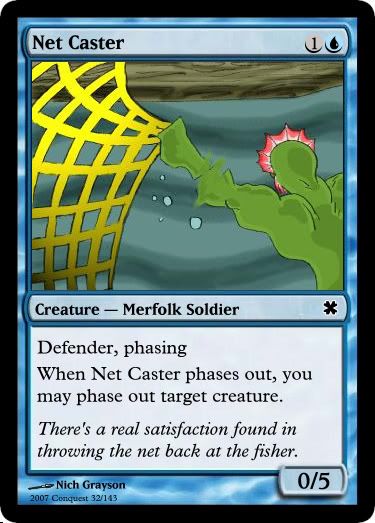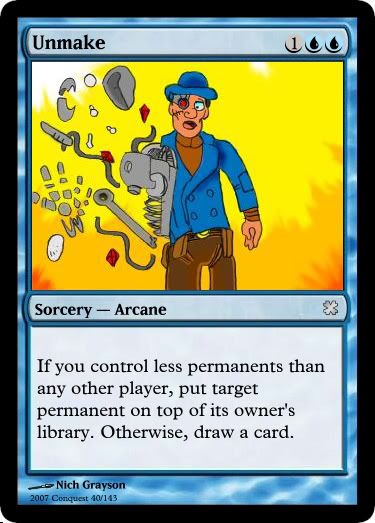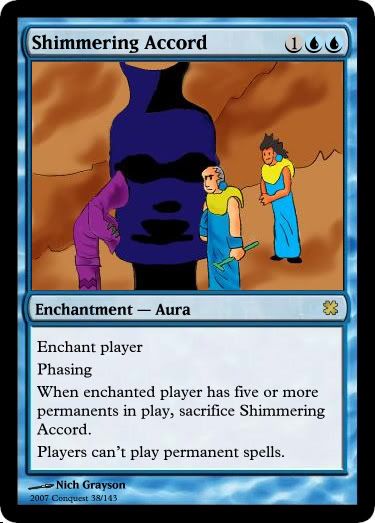
Removed from Reality
4/2/07
Welcome to what I hope will be an exciting preview for my new set, Conquest. I have devised six preview articles. I hope that by the time you finish reading this one you will have an idea of what the set has to offer and that your brain will be buzzing at the notion of what awaits you as the set preview unfolds.
Before I reveal the main thrust of Conquest, let me start by explaining how it came about in the first place. My friend Wamyc made a set last spring called Wastelands. After my friends and I had played the cards and seen the whole set, I got a real strong itch to make a set of my own. Not one that would compete with Wastelands, nor was it designed to fit like a hand in a glove. Both sets, you will find, have their own unique identity. But as I was defining my goals for the set, I made a conscious decision to not conflict with Wastelands in any strong way. There have been problems like this in Magic’s past. Here, we’re talking about small sets, but the idea of “inter-block design” stuck in my head.
I thought about the design space I wanted to explore, and what each color’s identity could be. I looked at Wastelands and how Wamyc had designed strong identities for each color, and yet left all sorts of little interactions available within the colors. And the way he did so was subtle to the point of near-chaos. Wasteland’s hybrid cards are a major theme of the set, but run the gamut of color combinations. It’s hard to tell what a player will do with all those choices. I really liked how this was done, but was immediately worried that I couldn’t design something equally loose-woven. I wanted to give each color a very strong direction, but provide tools for that same sort of interaction between each color. This way a player could build a mono colored deck and hit a theme strong, or they could splash any other color and sort of skew the results. What could the theme be if it had to have universal potential across colors, but also specific parameters to be explored? I almost instantly decided on “card types” as my theme. Each color would have a type focus, and this would be the framework the set was designed around.
The execution of this idea required some problems be immediately dealt with. Count the number of permanent types in Magic. There are only four. Count the number of colors in Magic. There are five. Additionally, one of those permanent types is defined by being colorless. So I’ve got 5 colors and 1 colorless and only 4 types (one of which has to be colorless) to work with for my theme. Should I also include Instant and Sorcery in my type theme? In the end I designed the set to be focused on permanent types.
Blue: The Odd Man Out
So where does that leave Blue? In the Mirrodin Block, Wizards of the Coast had a similar problem. They were exploring Artifacts and how each color interacted with them. One of the colors (Green) was the odd man out. Green interacted with Artifacts by not liking them at all. The Block on one level looks like “Artifacts and the other four colors” VS. “Green.” It was an asymmetrical approach to design that I thought could work for Conquest. The odd man out in this case would be Blue. It’s not that Blue doesn’t have a strong connection to permanents, but it was my favorite choice to play odd man. Why? Well, it’s just that Blue is the strongest color in Magic. Almost by default it climbs to the top of the pile in each set. In each Block. In each format. So I wanted to both acknowledge this truth, but also compensate for it. It was a combination of Flavor and Mechanics that dictated this decision. You will still be able to splash in some Conquest Blue for one of the other color’s themes, but Blue doesn’t play the “Permanents Game” in this set.

Phasing is back. Blue’s largest themes in this set is maintaining a small board presence. One of the ways it accomplishes this is to use Phasing to reduce how much is on the board at any one time. Phasing only appears on blue-aligned cards in Conquest, (meaning there may be an artifact or land with phasing.) If you need a refresher on how phasing works, I recommend reading the comp rules a few times. Or you can go Here where I’ve posted them for easy access. In a set where card types are the focus, permanents are by default also an issue. So blue will be playing most of its game from its hand, rather than from on the board. When it does have a card in play, it will want that card to have a high usefulness. The Eel not only mills cards the turn it comes into play, but also every other turn following for free. And it has an efficient mana cost to power/toughness ratio. I feel that if you like this card, you’ll love the direction Blue takes in Conquest. If the control game isn’t your thing, you’ll find Blue has other tricks up its sleeve too.

Net Caster, for example, is both an early turn defensive card AND an aggro-enabler. I like the way it clears blockers for a turn and provides blocks the next turn. (An important rules clarification for this card. If Net Caster phases out during your untap step, the creature you phase out with it will return during its controller’s next untap step.) Net Caster will be a good card in limited and may even have some constructed potential. 1U for a 0/5 wall is actually pretty useful in this set, even if it is only around half the time.

Here’s another card that plays on blue’s theme of having less cards in play than normal. As you can see, Unmake works well with Phasing, because phased out cards don’t count when it’s determining if you have less permanents in play. Also, it has a safety valve that’s pretty similar to Cycling 1UU. If you would prefer to “cycle” it, all you need to do is play it a turn in which your phasing permanents have phased into play. Unmake is another example of the choices blue spells will offer. Playing out of your hand instead of from the board has a disadvantage of not being able to reuse abilities. Spells either need to be recurrable or offer enough options that they can minimize the times in which they will be dead weight in your hand.
Hmm, that’s weird, Unamke has the subtype Arcane. I wonder what that’s about…
The last thing I want to say about Blue is that it also stands as a good introduction for Conquest even though it doesn’t work on the theme of a specific permanent type like the other colors do. In addition to focusing on a particular type, each color will also strengthen its relationship with other types. So, for example, Blue isn’t the color that cares about creature type, but as you can see it still uses creatures to achieve its goals. As a quick aside, I think that if blue were the “creature type” color in Conquest, it may still have Phasing because in order for blue to get strong creatures that can compete, there would certainly be some sort of drawback. That’s just Blue’s area of weakness. It approaches creatures differently than the color I chose (and the color is not Green, by the way.) It will be neat to see how each color not only approaches its type of focus, but each other type in the game.
The last card I want to reveal today is a blue enchantment that showcases the control element Blue will lean on for Conquest. I’ve tested it a lot and let me tell you – it’s a back-breaker.

“Players can’t play permanent spells.” In Conquest, that effect carries a lot of weight. Even if it only affects the game every other set of turns. Actually, if you can play a second Shimmering Accord when your first one is phased out, I’m betting many opponent’s would just pick up their deck and shuffle for next game.
You may ask yourself “Why is it an Aura?” By being an “Enchant player” Shimmering Accord can fit into very different deck types. You can have it enchant you and then manipulate the phasing rules to get around the restriction. Or, you can enchant your opponent and play a heavy bounce deck. It’s harder than you might think to get five permanents into play when you can’t play artifacts, creatures and enchantments half of the time.
You may also have asked “Why are those characters meeting in front of an Easter Island styled statue.” I’ll tell you. The scholars of the Chronal Observatory seen in the yellow and blue tunics are fiercely secretive, but word on the street is that statues like the one pictured on the card are the fonts of their fantastic powers.
I hope this article gave you something to whet your appetite. I am very happy with how Blue turned out in this set, and next time I’ll preview one more card that makes the Blue control deck just disgusting. I hope to see you then. Don’t forget to read the Comprehensive rules on Phasing, and to visit Wamyc’s Wastelands website.